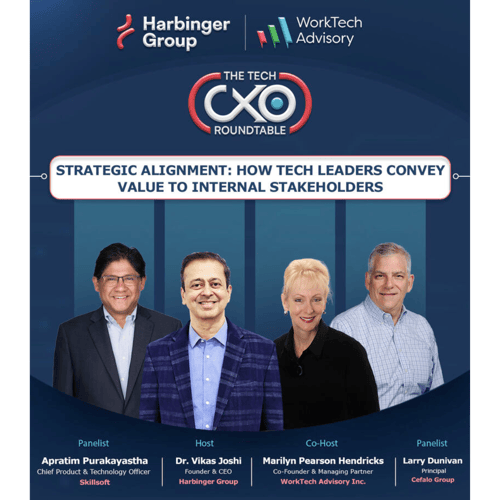Leading Through Disruption: Board and Executive Strategies in the Agentic AI Era
How are Boards and Executive teams staying ahead of AI-driven disruption? In this post, we...


In the relentless pursuit of driving an organization's technology vision and strategy, Chief Technology Officers (CTOs) play a pivotal role. Their ability to chart the course for innovation and technological advancement can mean the difference between a company's success or stagnation in a fiercely competitive business landscape. Yet, CTOs often encounter a significant hurdle – securing internal stakeholder buy-in. This obstacle becomes particularly daunting in the face of competing priorities, tight timelines and the ever-present pressure of delivering results.
At the heart of the matter lies a fundamental truth – an organization's primary focus should always be building value over features. However, the larger picture often blurs when individual goals and success metrics come into play. While a Chief Product Officer (CPO) might be driven to gain a competitive edge and secure better market pricing, a CTO's perspective revolves around harnessing the right technology to create a product that is not just cutting-edge but also extensible, scalable and easy to maintain.
So, how do you bridge these gaps and foster a harmonious synergy between technology vision and business strategy?
If you're a CTO navigating the intricate web of aligning technology vision with product strategy, implementation resources, operational constraints and the ever-present pressure of short-term feature priorities, we invite you to explore the insights shared in the first episode of Harbinger Group's panel discussion series – 'The Tech CXO Roundtable,' presented in association with WorkTech Advisory.
Marilyn Pearson Hendricks, Co-Founder and Managing Partner of WorkTech Advisory and Dr. Vikas Joshi, Harbinger Group Founder and CEO, led the discussion. Together, they united two industry titans on an insightful panel: Larry Dunivan, Executive Chairman of Mineral, former CEO of Namely, and Principal of Cefalo Group, and Apratim Purakayastha, Chief Product & Technology Officer of Skillsoft. Their combined expertise examined the importance of strategic communication, the art of articulating technology's impact on business strategy and the value of using strategic frameworks to foster alignment. Let's explore the key takeaways from this conversation.

Technology plays a central role in shaping an organization's short- and long-term success – period. Effective communication, especially from tech leaders, ensures everyone is on the same page and aligned with the company's strategic objectives.
The discussion started with a resounding consensus on the significance of strategic communication. Both Larry and Apratim emphasized the need for tech leaders to bridge the gap between the technical intricacies of their domain and the broader business objectives. CTOs and CEOs, despite their distinct responsibilities, [should] share the goal of advancing the company's growth and profitability. Aligning these objectives requires a shared vocabulary that resonates with organizational stakeholders.
"As a CTO, it's not always about building everything. Sometimes, the best strategy involves partnering and integrating. The key is to align your technology strategy with the business priorities. This means outlining the solution, considering whether to build, buy, or partner and projecting the expected outcomes over a 3-year horizon. It's about making a credible and believable investment case, tied to real business growth metrics." - Apratim Purakayastha
Strategic communication is more than just conveying information; it's about translating complex technical concepts into business terms that everyone can grasp. CTOs and CEOs must collaborate to develop a common language that resonates with their respective teams and other departments. Tech leaders can bridge the gap between the technical realm and the broader business landscape by focusing on what the company aims to achieve and why specific technology decisions matter.
To communicate strategically, CTOs and CEOs need to establish a mutual understanding of each other's roles and challenges. This entails building relationships based on trust and mutual respect, allowing them to navigate conversations seamlessly and facilitate decision-making. Moreover, they must prioritize using clear and unified language that highlights the business impact of their technology initiatives.
The conversation shifted to the art of articulating technology's impact on business strategy. Larry highlighted the importance of focusing on customer use cases and the problems technology solutions solve. He stressed the need for tech leaders to consistently ask themselves what challenges they are addressing and how their solutions align with the broader business goals. Apratim echoed this sentiment, emphasizing the significance of customer-centric thinking in every tech decision.
"An essential step for emerging CTOs is understanding the business strategy thoroughly before attempting to convey any technology strategy. You need to be on the same page with the company's overarching goals and objectives." - Apratim Purakayastha
Articulating the impact of technology goes beyond technical specifications and features; it's about clearly demonstrating the value proposition to internal stakeholders. Tech leaders must avoid jargon and buzzwords and instead focus on the real-world problems their technology solves. CTOs can create a compelling narrative that resonates with decision-makers by consistently connecting technology decisions to specific customer use cases.
Tech leaders must ensure that every technology initiative directly connects to customer needs and business outcomes. This requires a shift in mindset, where they view technology as an enabler of solutions rather than an end in itself. Moreover, they should cultivate a culture of customer-centric thinking within their teams to foster alignment and ensure that every technical decision serves a larger strategic purpose.
The conversation discussed the value of using strategic frameworks to align teams and stakeholders. Larry emphasized that a well-defined framework creates a shared vocabulary that promotes alignment and strategic focus. Apratim reinforced the concept by stressing the importance of understanding and solving specific business problems using the framework as a guiding tool.
"Strategic frameworks are the bedrock of success. Whether it's steering a company toward an IPO, securing a lifestyle business opportunity or adapting to changing circumstances, a well-defined and articulated framework is non-negotiable. It's the compass that keeps us on course in a sea of uncertainties." - Larry Dunivan
Strategic frameworks are extremely useful for crafting the roadmap, including decision-making criteria and aligning various departments and functions toward a common goal. These frameworks provide a structured way to evaluate technology as business initiatives, ensuring they align with the company's overall strategy. By leveraging a strategic framework, CTOs and other internal stakeholders can streamline decision-making, prioritize initiatives and eliminate wasteful efforts.
Tech leaders must adopt and promote a strategic framework that encapsulates the company's mission, vision and values. This framework should be a compass for technology decisions, ensuring that every initiative contributes to the company's overarching goals. Moreover, fostering a culture where teams actively reference the framework when discussing projects promotes alignment and prevents scope creep.
The panel discussion underscored the critical role of effective communication among CTOs and multiple internal stakeholders in driving business growth. Strategic communication, articulating the value of technology and embracing strategic frameworks are essential components for success. Tech leaders can create a powerful synergy that propels their organizations forward by aligning their perspectives, priorities and vocabulary. As technology continues to reshape industries, the collaboration between CTOs and CEOs becomes a necessity and a strategic advantage that propels businesses forward.

With a collective 100+ years of experience, WorkTech Advisory Inc. is the premier strategic advisory service supporting global HR and work technology organizations. We thrive on providing long-term, high-touch consultation to ambitious HR and work technology founders and their top executives. Our clients seek sustainable growth, risk reduction, and clarity on critical decisions that shape the growth performance and business value of their software business.


Wondering how to get real value from industry conferences? In this post, we share practical...